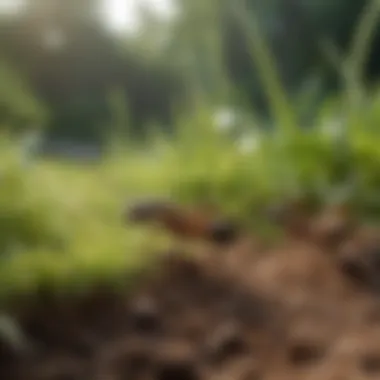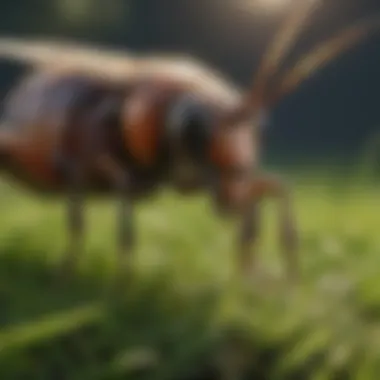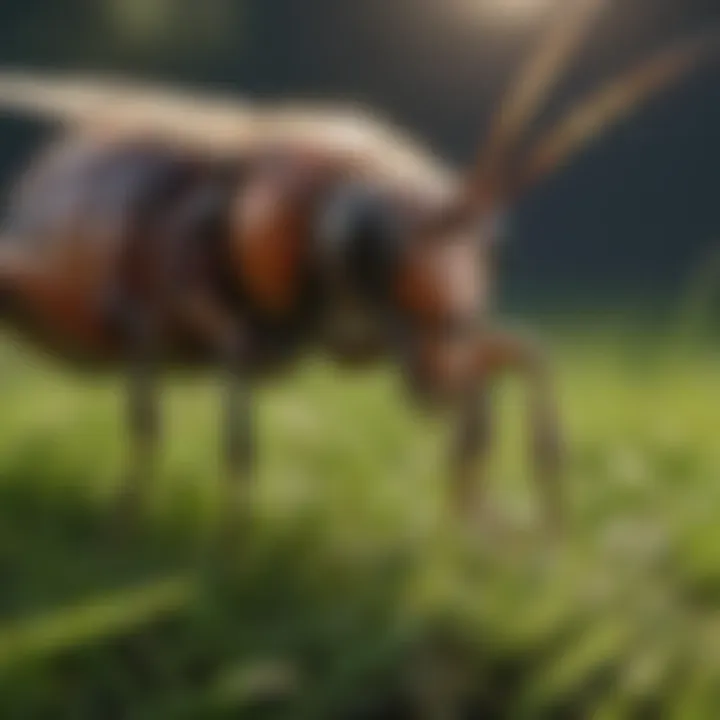Effective Insecticides for Lawn Ant Control


Intro
Managing ants in lawns is not just a matter of aesthetics; it’s crucial for the health of your green spaces. Ants can aid in the decomposition of organic matter and improve soil aeration, yet when their numbers balloon excessively, they can become a nuisance and hinder the growth of grass and plants. To effectively tackle this issue, knowing which insecticide to use, understanding its application, and considering potential environmental impacts is pivotal.
This guide aims to provide an extensive overview of the best insecticides available for ant control in lawns. By exploring various options and their active ingredients, we equip lawn enthusiasts and agricultural farmers with the tools to maintain a harmonious outdoor environment.
Overview of the Topic
Definition and Importance
In the simplest terms, insecticides are substances used to kill or manage harmful insects. When ants invade your yard, they can disrupt not only the landscape but also the biodiversity of beneficial insects. It’s essential to find a balance between effective pest control and preserving the environment.
Most importantly, understanding the importance of selecting the right insecticide hinges on effective application and minimal adverse effects on non-target species.
Current Trends
In today’s world, there is a growing preference for environmentally friendly solutions. Backed by advances in technology and biology, many new insecticides are formulated with natural ingredients to reduce their ecological footprint. These innovations lead us to a blend of effectiveness and sustainability.
Key Techniques and Practices
Step-by-Step Guide
Managing ants in lawns with insecticides requires a strategic approach:
- Identify Ant Species: Different ant species respond to various treatments. Knowing whether you deal with red imported fire ants or carpenter ants can guide your choice.
- Choose the Right Insecticide: Look for products containing active ingredients like pyrethroids or boric acid, known for their efficiency in exterminating ants. Ensure that the product is safe for lawns and nearby plants.
- Read the Instructions Carefully: Each insecticide will have specific guidelines for use. Dilution ratios, application intervals, and safety precautions must be adhered to.
- Apply on Dry Days: Ideally, apply insecticides on dry days to reduce runoff and improve efficacy.
- Follow Up: Monitor the area after application. If the infestation persists, consider reapplying or trying a different product.
Tools and Equipment Needed
Having the right equipment on hand can make the process significantly easier. Some essential tools include:
- Sprayers: Handheld or backpack sprayers for precise application.
- Protective Gear: Gloves, masks, and goggles to ensure safety during application.
- Measuring Cups: For accurate mixing of insecticides with water.
Challenges and Solutions
Common Obstacles
Even with the best intentions, managing ant infestations can pose several challenges:
- Resistance to Insecticides: Over time, ants can develop resistance to specific chemicals, making them less effective.
- Environmental Concerns: Some synthetic insecticides may harm beneficial insects as well, contributing to imbalances in the ecosystem.
- Application Timing: Weather conditions can impact the effectiveness of the insecticides, leading to frustrating results.
Innovative Solutions
To confront these challenges, innovative strategies and products are emerging. For instance, baiting systems allow ants to consume the insecticide, carrying it back to their colony and effectively eliminating it from within. Moreover, integrating organic practices such as introducing nematodes into the soil can help control ant populations without the harmful effects of conventional insecticides.
"Choosing the right insecticide is not merely about effectiveness but about preserving the delicate balance of your lawn’s ecosystem."
Understanding Ant Infestations in Lawns
Ant infestations in lawns can become a thorn in the side for homeowners and garden enthusiasts. Recognizing the ins and outs of these pests is crucial for taking effective measures against them, particularly when it comes to maintaining lawn health. The earlier you pinpoint the problem, the quicker you can implement solutions.
From unsightly mounds to potential damage to your grass, understanding the various types of ants and their behaviors can inform your pest control strategies. This section will dissect the nature of ant infestations, identifying key characteristics that set different species apart, and the red flags that suggest your lawn is at risk.
Types of Ants Commonly Found
Carpenter Ants
Carpenter ants are more than just common pests; they can cause substantial damage to structures, as they carve out galleries in wood for nesting. They thrive in damp or decaying wood but can also establish colonies in soil. Their ability to go unnoticed for long periods makes them particularly dangerous.
One significant characteristic of carpenter ants is their preference for high-moisture environments. They often signal potential wood decay in your home or lawn, making them not just a nuisance but a sign of an underlying issue. Their presence in your lawn may not be as conspicuous as other types, but they can sap the strength of your plants over time.
Fire Ants
Fire ants, notorious for their painful stings, are easily recognizable. They create visible mounds that can reach several inches high, creating an eyesore while posing risks to both pets and humans. Their aggressive nature and the speed at which they establish colonies make fire ants a significant concern for any lawn.
One unique aspect of fire ants is their ability to form floating rafts during floods, showcasing their adaptability. However, even though they might have a useful role in controlling some insect populations, their aggressive behavior outweighs these benefits, making them a headache for homeowners.
Argentine Ants
Argentine ants are small and brown, creating extensive colonies that can outcompete local ant species for resources. Their presence can lead to a decline in other beneficial insects, as they are known to protect aphids from predators in exchange for honeydew. This relationship is particularly damaging as it can lead to further issues in lawn health.
Their ability to form supercolonies means that if you see one, you likely have a lot more nearby. They adapt quickly, making them difficult to control. This makes it crucial to recognize their activity early, so proactive measures can be taken before they dominate your lawn.
Pharaoh Ants
Pharaoh ants are a nuisance, primarily because they can establish colonies without drawing too much attention. They prefer warm, humid environments, and their small size allows them to forage for food unseen. Their impact often manifests in spreading disease and contamination rather than physical lawn damage.
One key feature of pharaoh ants is their ability to reproduce quickly, making them resilient against common control measures. Their stealthy ways can lead to an unexpected infestation if not monitored carefully. Understanding their habits is essential for long-term pest management strategies in your lawn.
Signs of Ant Activity
Mounds and Nests
Ant mounds are the most apparent sign of ant activity in your lawn. These structures can range from small hills to larger, conical formations, depending on the ant species. Not only do they detract from the aesthetics of your yard, but they also affect the structure of the soil.
The presence of these mounds often indicates a well-established colony. They can disrupt water drainage and facilitate soil erosion, hindering your grass’s ability to thrive. Observation of ant mounds should prompt immediate action to prevent further issues.
Visible Trails


If you notice trails of ants marching back and forth, it’s a telltale sign of foraging behavior. Ants operate on pheromones, creating paths for others to follow to food sources. This behavior not only signifies an active colony nearby but also reveals potential food sources they might be exploiting.
Recognizing these trails is beneficial for determining where to focus your control measures. Ignoring visible trails could lead to a larger infestation down the line, making it critical to address them as soon as possible.
Damage to Grass
Keep an eye out for any discoloration or patches of dying grass. Ants can disrupt the root systems of your grass, leading to weakened plants. The damage may manifest as wilting or browning patches that can make your lawn look lackluster.
This specific symptom reflects the underlying issue with ant activity, suggesting roots have been disturbed. It’s vital to act promptly if you observe these signs to reverse the damage and restore your lawn’s health.
Impact of Ants on Your Lawn
Understanding the impact of ants on your lawn is crucial, particularly when considering control measures. Ants might be seen as simple nuisances, but they can cause various levels of damage to your turf, affect the ecosystem, and alter soil characteristics. It's vital to assess both the positive and negative effects they may have on your lawn. Evaluating this impact can help you make informed decisions about handling these insects and maintaining lawn health.
Identifying Lawn Damage
Identifying the damage ants inflict on your lawn can play a pivotal role in determining the best course of action. Here are some specific areas impacted by ant activity.
Root Disruption
Ant colonies, especially larger ones, can disrupt grass roots significantly. They dig to create nests and highways, which can lead to the uprooting of grass and other plants. Healthy root systems are essential for grass survival; they provide the necessary nutrients and water from the soil. When these roots are compromised, grass can become stressed and turn brown.
- Key Characteristic: This disruption impacts the nutrient flow essential for healthy plant growth.
- Contribution: Addressing root disruption helps focus on immediate lawn repairs, leading to healthier growth overall.
- Unique Feature: Recognizing this factor allows homeowners to take preventive measures before extensive damage occurs.
- Advantages: Understanding root disruption can lead to better strategies, ensuring a lush lawn.
- Disadvantages: However, if not identified early, it often results in costly lawn restoration efforts later on.
Soil Aeration
Ants can inadvertently aid in soil aeration, which might sound contradictory at first. Their tunneling activities help to break up compacted soil and allow air, water, and nutrients to reach the roots better. However, this benefit comes with a drawback.
- Key Characteristic: Improved soil aeration promotes better root growth.
- Contribution: This aspect of their activity can be beneficial, particularly in clay-heavy soil.
- Unique Feature: While this can enhance soil quality, it might also expose roots to other pests.
- Advantages: Well-aerated soil generally supports a robust lawn.
- Disadvantages: Yet, if too many ants are present, their tunneling may destabilize root systems.
Competition with Grass
Ants often engage in competition with grass for resources. They feed on seeds and other organic matter, limiting what is available for grass growth. This competitive aspect is harmful when ant populations reach high levels.
- Key Characteristic: The loss of seeds can significantly hinder new grass growth.
- Contribution: By assessing this competitive behavior, lawn care can be better focused and tailored.
- Unique Feature: Recognizing this can lead to integrated pest management strategies that balance ant populations.
- Advantages: Managing this competition ensures more nutrients are available for the grass instead of being consumed by ants.
- Disadvantages: Without effective management, lawns can become patchy and unhealthy rather quickly.
Beneficial Versus Harmful Ants
In discussions about ants, it becomes clear that not all ant species are detrimental. Recognizing beneficial ants can help in distinguishing pest control actions that benefit the lawn ecosystem.
Roles in Soil Health
Some ant species notably contribute positively to soil health. They help with organic matter decomposition and nitrogen fixation in the soil, which supports plant growth. Their foraging activities can also aid in the mixing of soil layers, enhancing nutrient dispersion.
- Key Characteristic: They play a significant role in maintaining the soil structure.
- Contribution: The contributions of beneficial ants promote overall ecosystem balance.
- Unique Feature: Notably, these species can improve soil fertility without direct harm to the grass.
- Advantages: Including beneficial ants as part of your landscape can create a more productive environment.
- Disadvantages: Mixing ant control measures without discrimination could negatively affect these beneficial species.
Sheltering Other Pests
On the flip side, certain ant species have a knack for sheltering other pests, like aphids. They protect these pests from predators in exchange for the honeydew they produce. This relationship can create more significant problems in a lawn when pests like aphids proliferate.
- Key Characteristic: This symbiotic relationship can sometimes lead to larger pest issues.
- Contribution: It highlights the complexity of pest relationships in gardens and lawns.
- Unique Feature: Understanding these dynamics is essential for pest control strategies.
- Advantages: Recognizing this behavior can lead to more targeted control measures.
- Disadvantages: Failing to address the sheltering behavior might allow pest populations to grow unchecked, leading to further lawn health issues.
The dual nature of ant activity in lawns reveals the importance of discernment in pest management. By recognizing which species are beneficial and which are harmful, homeowners can create a balanced approach to lawn care that cultivates health and productivity.
Choosing the Right Insecticide
Selecting the appropriate insecticide in the battle against ants is no small task. Understanding the specific requirements of your lawn, the types of ants present, and the varying insecticides available can make or break your pest control efforts. The goal here is to use a method that not only effectively targets those pesky ants but also keeps your lawn and surrounding environment in tip-top shape.
Ants are clever creatures. They can quickly become habituated to certain substances, so a one-size-fits-all approach will soon fizzle out. This is where the specificity of choosing the right insecticide shines through. Not only does this consideration affect immediate results, but it also plays a part in the long-term health and resiliency of your lawn.
Types of Insecticides
Chemical Insecticides
Chemical insecticides typically rely on synthetic compounds designed to target and eliminate ants swiftly. This method has been popular among homeowners for its quick action; many users report visible results in just a few days.
However, there's a downside. One key characteristic of these insecticides is that their effectiveness can wane over time. Ant colonies often develop resistance against commonly used chemicals, leading to the persistent problems experienced by many homeowners. However, when used correctly and in combination with other strategies, chemical insecticides can offer a robust solution.
Pros:
- Rapid results.
- Effective for large infestations.
Cons:
- May lead to resistance in ant populations.
- Can affect non-target species.
Natural Insecticides
On the flip side, natural insecticides are garnering attention for their eco-friendly properties. These products are derived from plants or minerals and often contain compounds that are effective against ants without inflicting harm on beneficial insects. Many lawn enthusiasts favor natural insecticides for this very reason.
A notable feature of natural insecticides is their persistent nature, as they can often disrupt an ant's life cycle over time without the need for constant reapplication. However, results may not be as swift as their chemical counterparts, and some formulations might require more frequent applications.
Pros:
- Environmentally friendly.
- Safer for beneficial insects.


Cons:
- Slower effectiveness.
- May need frequent application.
Bait Formulations
Bait formulations stand out as a unique strategy in ant control. Unlike sprays or granules, baits attract ants, who then take the poison back to their colony, affecting the entire population. This indirect method of attack has proven effective for many lawn care enthusiasts.
The key characteristic of bait formulations is their slow-acting nature, which allows the foraging ants to return to the colony before the insecticide takes its toll. While this feature increases effectiveness across the colony, it also means that visible reductions in ant activity may take a bit longer than other methods.
Pros:
- Targets entire ant colony effectively.
- Reduces the chances of resistance.
Cons:
- Requires proper placement to be effective.
- May be ineffective against fast-moving ants.
Key Active Ingredients to Consider
Understanding the active ingredients in insecticides can further guide you in choosing the perfect product.
Boric Acid
Boric acid has made a name for itself as an effective alternative in ant control. Its mode of action is relatively simple; it affects the digestive system of insects, causing them to fail to absorb food. This key characteristic, coupled with its long residual effect, makes boric acid a go-to choice for many. When used correctly, it can lead to significant reductions in ant numbers. However, it is less effective in the presence of moisture.
Fipronil
Fipronil is a modern chemical that has demonstrated itself as a powerful solution against a variety of ants. It disrupts the insect’s nervous system, leading to a quick demise. Homeowners appreciate it for its long-lasting performance, which often extends up to three months in the lawn. Nonetheless, caution is necessary, as it can affect other insects as well.
Imidacloprid
Lastly, imidacloprid, a member of the neonicotinoid family, has grown in popularity. Its impact on the nervous systems of ants is quite similar to that of fipronil. What sets it apart is its high specificity towards pest insects, making it less harmful to beneficial species. However, some reports suggest that it may have implications for bee populations, warranting cautious use.
Conclusion: Choosing the right insecticide involves weighing the options available and considering how they align with your lawn’s needs. Different types have their strengths and weaknesses, but understanding the nuances can help you manage those ants efficiently.
Application Methods for Ant Insecticides
Understanding the application methods for ant insecticides is of utmost importance when tackling infestations effectively. The method you chose can significantly impact not only the success of your pest control efforts but also the environmental safety of your lawn. Each method of application comes with its own sets of advantages and disadvantages, so it is vital to understand them fully to make an informed choice. This section dives deeper into granular applications, liquid insecticides, and baiting strategies, which are the primary methods used for controlling ant populations in lawns.
Granular Applications
Pros and Cons
Granular insecticides are often seen as a popular choice among gardeners and lawn care enthusiasts. One of their defining traits is ease of use; they can be easily spread across a lawn, making it simple for even novice users to apply effectively. Their slow-release formulation can provide longer-lasting control compared to some liquids. However, they might not always target the hidden ants, especially if nests are deep underground. There's also the risk of environmental contamination from runoff, especially after rains, which can carry excess granules into unintended areas.
Best Practices
When using granular applications, following best practices is essential for maximizing efficiency. First, it’s important to evenly distribute the insecticide using a proper spreader to avoid clumping, which can lead to ineffective treatment. Watering the treated area lightly after application helps the granules settle into the soil, enhancing effectiveness. A unique feature of these applications is the timing; applying them when ant activity is high can yield better results. Avoiding windy days is also crucial, as it can disperse the granules away from your target zone.
Liquid Insecticides Usage
Spray Techniques
Spray techniques can offer an immediate impact against ant populations. With liquid insecticides, users can directly target the problem areas, allowing for precision that granular products may lack. The ability to mix with other solutions for additional effectiveness is another notable characteristic. However, improper spray techniques can lead to uneven application or drift, affecting non-target species. Here, practice makes perfect—ensuring your spray pattern envelops the intended areas thoroughly ensures maximum control.
Timing for Maximum Effectiveness
The timing for liquid insecticide application is crucial for achieving optimal results. For instance, applying during the early evening or early morning, when ants are most active, can enhance the efficacy of the treatment. Additionally, environmental conditions matter; applying on calm, dry days prevents scattering caused by wind and ensures the solution adheres to its target. Notably, the effectiveness can wane with heavy rain, which may wash away the insecticide, rendering it less effective or requiring reapplication.
Baiting Strategies
Location Selection
Selecting the right location for baiting can significantly influence the effectiveness of your pest control strategy. Baits should be placed near ant trails or areas where they are most active, ensuring that ants are drawn to the bait quickly. This method's key characteristic is its ability to lead ants back to their nests, thereby eliminating the colony rather than just individual insects. However, over-reliance on bait can pose risks if not monitored; if ants don't consume it quickly enough, it may go to waste or inadvertently attract non-target species.
Bait Types and Efficacy
There's a variety of bait types available, including gel, solid, and liquid formulations. Each type has its advantages, with gels often seen as particularly effective due to their palatability to ants. The efficacy of bait depends on the formulation and the active ingredients used, as some may attract certain species better than others. Utilizing baits with slow-acting insecticides allows worker ants to carry the poison back to the nest, hitting the heart of the problem. However, one must be wary of environmental impacts, as some baits can be harmful to pets or non-target wildlife.
Environmental Considerations
When tackling an ant problem in your lawn, it’s crucial to think twice before reaching for an insecticide. The Environmental Considerations aspect dives deep into how our pest management choices play out not just for ants, but for the entire ecosystem of your yard. Making eco-friendly decisions can maximize the health of your grass, protect nearby natural wildlife, and keep beneficial insects intact—elements that contribute to a vibrant and balanced environment.
Impact on Non-target Species
Protecting Beneficial Insects
Insecticides don't only target unwanted pests like ants; they can unfortunately affect beneficial insects as well. These little allies, like ladybugs and bees, play vital roles in pollination and pest control. Protecting beneficial insects is therefore a crucial part of choosing any ant control method. A significant characteristic of these insects is their role in natural pest management—reduce their population, and you might just open the door for more pests to stroll in.
Why is this important for our discussion? If insecticides harm these beneficial insects, it can lead to a ripple effect, undermining local biodiversity. A unique trait of such protection methods is the ability to opt for targeted insecticides that mainly affect ants while leaving beneficial insects unharmed. This approach lesser the risk of creating gaps that other pests might fill, ensuring a well-maintained lawn.
Mitigating Risks to Wildlife
Wildlife encompasses everything from birds to small mammals, and many of them rely on your yard for habitat or food. When you apply insecticides, the potential risk to these creatures cannot be overlooked. Mitigating risks to wildlife means selecting pest control methods that consider the broader implications of treatment. You see, an important characteristic here is that many common insecticides can inadvertently poison non-target species if ingested.


Focusing on safer alternatives or using application techniques that limit exposure can go a long way. For instance, using bait stations positioned away from bird feeders can greatly reduce the risks. What’s essential to keep in mind is that while controlling your ant problem is necessary, it shouldn’t come at the expense of destroying the local wildlife.
Soil and Water Safety
Runoff Concerns
When it rains, all the chemicals you’ve applied to your lawn can wash away, leading to runoff problems. This concerns us all. The specific aspect of runoff is about how pesticides enter waterways and soil beyond your intended area of application. This can lead to contamination that not just affects the surrounding environment but can also pollute drinking water sources.
Why is this concern significant? Many people misunderstand that residue from chemicals can linger, making any treatment chosen very impactful. Engaging in practices such as using less toxic products or applying them during dry conditions can significantly lessen environmental risks. Always remember, what goes in must come out, and managing your lawn shouldn’t lead to unintended consequences.
Long-term Soil Health
Soil is a living entity, yet the indiscriminate use of chemicals can disrupt its delicate ecosystem. Considering long-term soil health is paramount in managing ants without causing other issues. The vital aspect of this is understanding that healthy soil supports a myriad of organisms that, in turn, foster plant growth, including your precious grass.
A unique feature here is that healthier soils sustain beneficial microbes which can naturally combat pests. For instance, instead of chemical-heavy treatments, one could explore organic options that enrich soil rather than deplete its nutrients. With these smarter choices aimed at improving soil health, over time, you will notice reduced pest issues in general, moving you closer to an sustainably managed lawn.
Sustainable Pest Management Techniques
When it comes to maintaining the health of your lawn while managing ant populations, sustainable pest management techniques are invaluable. This approach emphasizes not just the eradication of pests, but also the preservation of ecosystem balance. By integrating various practices that minimize environmental impact, you can effectively control ant infestations without resorting solely to chemical solutions. This section will explore key techniques that both conserve resources and promote a healthier yard.
Integrated Pest Management (IPM) Principles
Monitoring and Assessment
Monitoring and assessment are foundational to Integrated Pest Management (IPM). This process involves regularly checking for signs of ant activity and assessing their impact on your lawn. The key characteristic of this approach is its proactive nature. Instead of waiting until damage is evident, monitoring helps to catch infestations early, allowing for timely intervention.
One unique feature of monitoring is the use of traps or bait stations to gauge ant populations. This method is not only effective in detection but also provides insight into which ant species are present, allowing for more targeted treatments. The benefits of monitoring are twofold: first, it effectively reduces the amount of pesticides in use; second, it fosters a better understanding of your lawn's ecosystem and the specific threats it faces. However, a drawback can be that it requires diligence and consistency from the homeowner, which may be less appealing for those with a busy lifestyle.
Threshold Levels for Action
Threshold levels for action within IPM principles involve determining when ant populations reach a point where intervention is necessary. This concept helps prioritize efforts and resources toward pest control. The key characteristic here is the ability to distinguish between tolerable nuisances and situations that need urgent attention.
By setting these thresholds, homeowners can act in a timely manner without panicking over every ant sighting. A unique feature is the flexibility of these thresholds based on the individual lawn ecosystem; what might be acceptable in one garden could be intolerable in another. This method offers significant benefits, such as reducing unnecessary pesticide application, but it requires a good understanding of ant behavior and lawn health that some may find challenging.
Cultural Practices to Deter Ants
Proper Lawn Maintenance
Proper lawn maintenance serves as a fundamental strategy in pest control, aiding in deterring ant colonies from settling in your yard. Key characteristics include regular mowing, watering, and fertilization, all of which contribute to a robust turf that can better withstand invasions. A well-maintained lawn is less likely to attract ants since there’s often less food and shelter available.
The unique feature of this practice is its holistic approach. Instead of focusing solely on chemicals, you create an environment that naturally discourages pests. Regularly aerating the soil can also be beneficial, as it improves drainage and reduces conditions that may be favorable for ants. However, the downside is that it often requires a significant time commitment and may demand specific knowledge or skills.
Natural Barriers
Implementing natural barriers serves as another effective way to deter ants, using plants and physical structures to create obstacles. The key characteristic of this method is its reliance on non-toxic measures. For example, planting mint or other herbs known to repel ants can keep their colonies at bay.
One unique advantage of natural barriers is their dual-purpose functionality: they beautify your lawn while also serving as deterrents. However, a point to consider is that while these barriers can reduce pest populations, they may not eliminate them entirely, making them more of a supplementary strategy than a standalone solution.
In the journey towards sustainable pest management, integrating these techniques not only helps control ant populations but also fosters a healthier and more vibrant lawn.
Future Trends in Ant Control
As we advance into a future laden with technological innovations and ecological consciousness, the realm of ant control is witnessing transformative trends that promise enhanced effectiveness while mitigating environmental repercussions. Understanding these trends provides insights into how we can adeptly manage ant populations, protecting not just our lawns but the delicate ecosystems surrounding them. Ant control is not just about eliminating pests; it's about finding sustainable practices that harmonize with our growing awareness of environmental stewardship.
Advancements in Biological Control
Utilizing Predatory Species
Utilizing predatory species serves as a fascinating approach in the ongoing battle against ant infestations. This method relies on natural enemies of ants, such as certain types of beetles and parasitic wasps, to keep ant populations in check. One of the key characteristics of this strategy is its ability to integrate seamlessly into existing ecosystems, fostering a balanced environment.
Why is this method gaining popularity? It's because it taps into nature's own resources. By introducing or conserving natural predators, lawn owners can reduce reliance on chemical insecticides, which can sometimes lead to adverse effects on beneficial organisms. The unique feature of using predatory species is their self-sustaining nature; once established, they can provide ongoing control of ant populations without repetitive inputs.
However, there are considerations to keep in mind. The introduction of any predatory species must be done judiciously, as it may unintentionally disrupt the local ecosystem. Understanding the specific dynamics of the area is crucial for success.
Microbial Solutions
Microbial solutions represent another significant advancement in ant control. These biological agents use naturally occurring microbes to target specific pests, including ants. The key characteristic of microbial solutions is their ability to affect only the ants, leaving beneficial species unharmed. This selectivity makes them a compelling choice for those aiming for environmentally sensitive pest management.
One unique feature of microbial solutions is their varied modes of action. Some microbes can disrupt the digestive systems of ants, while others may compromise their life cycles. This multifaceted approach allows lawn owners to tackle ant problems from multiple angles, further increasing efficacy.
Yet, as alluring as microbial solutions may be, their effectiveness can sometimes be influenced by environmental factors, such as temperature and moisture levels. This means that the timing of applications must be carefully considered to ensure the best results.
Innovations in Insecticide Formulations
Reduced Toxicity Options
Reduced toxicity options are gaining traction among environmentally conscientious gardeners and farmers. These insecticides are designed to be effective against ants while proving non-harmful to other non-target organisms, thus fostering healthier ecosystems. The hallmark of reduced toxicity options lies in their selective action; they target specific pests while minimizing collateral damage.
The appeal of this choice lies in its alignment with sustainable gardening principles. By using reduced toxicity formulations, practitioners can keep their lawns free from ants without compromising the health of beneficial insects or other wildlife. Furthermore, many of these options often degrade more rapidly in the environment, presenting less risk of long-term contamination.
Nevertheless, users should remain aware that while these insecticides may be safer, they often require stricter adherence to application guidelines and may need more frequent treatments to maintain effectiveness.
Extended Residual Effects
Extended residual effects refer to insecticides engineered to persist longer in the environment, providing prolonged protection against invading ant populations. This characteristic has made such formulations a staple in ant management. Their ability to remain active for weeks or even months can be a real game changer for busy lawn owners who prefer long-lasting solutions.
The obvious advantage here is the reduced frequency of application. Fewer applications equate to less labor and lower material costs. This makes extended residual effects an attractive option, particularly for those managing larger spaces or commercial properties.
However, it is critical to note that longer-lasting insecticides can pose risks to non-target species if not applied carefully. Understanding the local ecology becomes essential here to avoid unintended consequences that such persistent formulations may bring.
In summary, the realm of ant control is rapidly evolving. By exploring biological control methods and innovative insecticide formulations, homeowners and agricultural professionals can take informed steps toward maintaining healthy lawns while being mindful of environmental implications.



